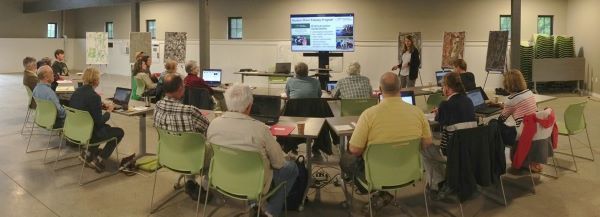In This Issue:
- Amphibians on the Move: Update
- Local Planners Play A Key Role in Conserving Biodiversity
Amphibians on the Move: Migration Update
This spring, dedicated volunteers throughout the Hudson River estuary watershed have been helping thousands of frogs and salamanders on their annual migration journeys. Amphibian Migrations and Road Crossings (AM&RC) project participants collect data about the seasonal movements of amphibians from forests to woodland pools where they breed and deposit eggs. Peak migration activity was recorded by AM&RC volunteers on the nights of March 18 and March 24, with continued movements on March 28 and March 31. On these nights, volunteers from Westchester County up to the Capital District recorded their observations and helped migrating amphibians that encountered roads by moving them across safely.
At this point in the season, evidence of successful breeding (PDF) can be seen in woodland pools, including egg masses of wood frogs, spotted salamanders, and Jefferson/blue-spotted salamander complex. The migrations of pool-breeding amphibians will start to wane except in the coldest parts of the watershed, where later-arriving or departing salamanders may still be on the move. In the coming months, the pools will be filled with frog tadpoles and salamander larvae, which will need to develop and leave the water before the temporary pools dry up. This life-cycle is a fascinating and important part of our forest ecosystems in the estuary watershed, and it is a reason to conserve connected habitats that allow for safe movement of wildlife.

Local Planners Play a Key Role in Conserving Biodiversity
Through a partnership with Cornell University’s Department of Natural Resources and the Environment, the Hudson River Estuary Program works with watershed municipalities to ensure they have access to accurate, scientific data and have the necessary tools and training to pursue effective conservation planning. Research by Cornell’s Center for Conservation Social Sciences looked at how participation in our outreach and training programs resulted in municipal actions to address biodiversity in the estuary watershed. The results were recently published in the journal Land Use Policy and consider the motivation, capacity, and barriers to achieving conservation outcomes in municipal land-use planning. The article, "Incorporating Biodiversity in Municipal Land-Use Planning: An Assessment of Technical Assistance, Policy Capacity, and Conservation Outcomes in New York's Hudson Valley" can be downloaded now (PDF), and an overview of the findings is available in the Cornell Chronicle.

|



